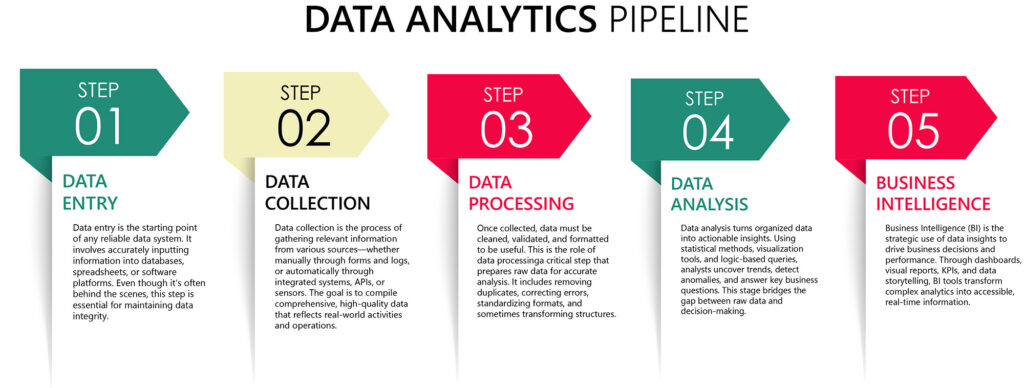
Importance of Data Collection
Organizations across industries are investing heavily in analytics, AI, and automation. But no matter how advanced your tools or models are, their output is only as good as the data they’re built on. That’s why effective data collection isn’t just the first step it’s the most critical.
Why Data Collection Matters
At its core, data collection is about capturing accurate, relevant, and timely information from a variety of sources. Whether it’s transactional data from a CRM, operational metrics from IoT devices, or behavioral insights from website interactions, these inputs fuel every downstream decision-making process.
When done properly, data collection:
- Ensures consistency and accuracy across your reporting
- Reduces bias in analysis and predictions
- Improves model performance by providing high-quality training data
- Enables traceability and compliance, especially in regulated industries
- Drives operational efficiencies by making gaps and redundancies visible
The Cost of Poor Data Collection
Many organizations underestimate the cost of bad data. According to Gartner, poor data quality costs businesses an average of $12.9 million annually. These costs show up as:
- Missed opportunities due to inaccurate insights
- Time-consuming manual corrections
- Poor customer experience due to outdated or duplicate records
- Reputational risks from compliance violations
When collection methods are inconsistent or poorly designed, analysts are left cleaning data instead of exploring it delaying insights and decision-making.
Real-World Example: The Double Cost of Poor Data Collection
Imagine this scenario: your organization hires a team of data entry associates to digitize paper records or input customer data into a system. The task seems straightforward, and the hourly rate is relatively low so far, so good.
But there’s a problem. The associates receive minimal training, the data entry standards are unclear, and some team members are unmotivated or disengaged. As a result, the data being collected is riddled with inconsistencies, errors, and missing values. Maybe phone numbers are in the wrong format, dates are inverted, or key fields are left blank entirely.
At first, no one notices. But weeks or months later, your data analysts begin working on a reporting project or dashboard, only to find they can’t trust the data. It doesn’t align, it breaks queries, and it’s full of noise. The insights are unreliable, and leadership is frustrated.
Now, to salvage the situation, you bring in a data cleaning professional or consultant someone with a higher skill set and a much higher hourly rate to audit, cleanse, and reformat the dataset. In the end, you’ve paid twice: once for the bad data entry, and again to fix it.
And that’s not even counting the opportunity cost of delayed reports, missed insights, or poor decisions made from faulty data. Whether it’s through better training, improved processes, or smarter automation, investing in quality from the start saves time, money, and headaches down the road.
Key Principles of Effective Data Collection
To avoid these pitfalls, data professionals must design and implement collection strategies with care. Some best practices include:
1. Define Clear Objectives
Know what questions you’re trying to answer before you collect the data. This helps eliminate unnecessary inputs and ensures relevance.
2. Standardize Input Methods
Use consistent formats and validation rules to avoid garbage in, garbage out. Whether it’s a form, API, or sensor, consistency is key.
3. Automate Where Possible
Manual data entry is error-prone and inefficient. Automating data pipelines improves both speed and reliability.
4. Ensure Security and Privacy
With growing regulations (e.g., GDPR, CCPA), data collection must be secure and compliant. Collect only what’s necessary, and be transparent with users.
5. Continuously Monitor Quality
Implement feedback loops to flag anomalies, duplicates, or missing values early — before they make their way into dashboards or models.
While analysis and visualization often get the spotlight, data collection is where real value begins. For data professionals, investing in robust collection frameworks is an act of foresight one that pays off in cleaner datasets, faster insights, and smarter decisions. Better data in means better insights out. And that starts with mastering the art and science of data collection.
